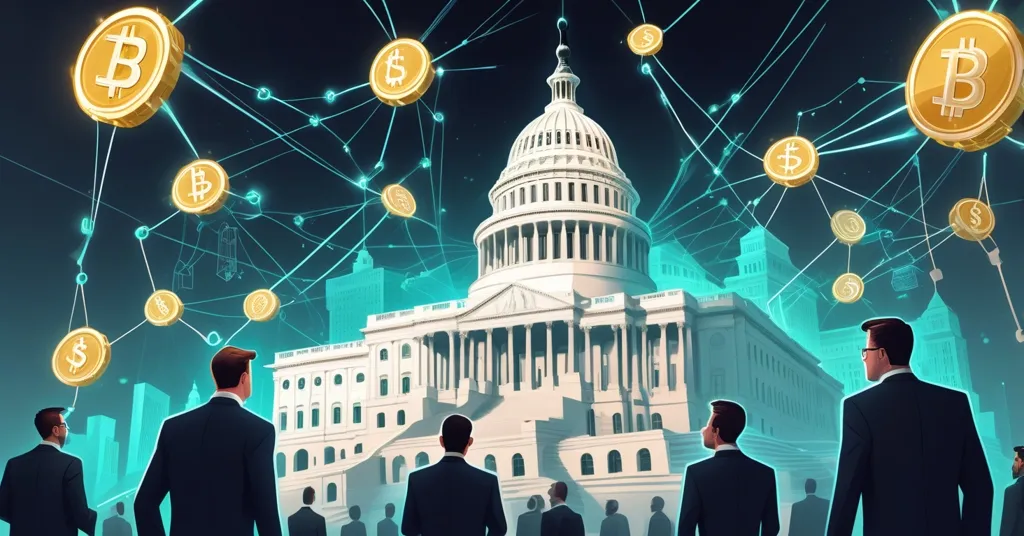Trump’s GENIUS Act: Stablecoin Law Ignites U.S. Crypto Surge and Ethical Concerns

Trump Signs GENIUS Act: U.S. Stablecoin Law Sparks Crypto Boom and Controversy
President Donald Trump has etched a historic mark on U.S. financial policy by signing the GENIUS Act into law, the first legislation targeting digital assets in the nation’s history. Focused on regulating stablecoins, this move has ignited a frenzy of activity across the cryptocurrency and traditional finance (TradFi) sectors, positioning the U.S. as a potential global blockchain hub while raising serious questions about risks, ethics, and oversight.
- Groundbreaking Law: GENIUS Act becomes the first U.S. digital asset legislation, signed by Trump to make America the “crypto capital of the world.”
- Industry Explosion: Tether plans U.S.-compliant stablecoins, banks like JPMorgan join the race, and Polymarket eyes a domestic comeback.
- Ethical Shadows: Trump’s personal crypto ventures and opaque investors like Aqua1 Foundation stir transparency concerns.
Regulatory Breakthrough: What the GENIUS Act Means for Stablecoins
Passed with a commanding 308-122 bipartisan vote in the House, the GENIUS Act isn’t just ink on paper—it’s a seismic shift for stablecoins, those digital currencies pegged to stable assets like the U.S. dollar to avoid the wild swings of Bitcoin. Used for everything from cross-border remittances to powering decentralized finance (DeFi) platforms—think lending or trading without banks—stablecoins are the workhorses of the crypto world. This law, signed on a Friday amid much fanfare, mandates strict compliance: issuers must undergo third-party audits of their fiat reserves within three years, ensuring they actually hold the cash or equivalents they claim. Oversight falls to heavy hitters like the Office of the Comptroller of the Currency (OCC), which regulates national banks, and the Federal Reserve, the backbone of U.S. monetary policy. Non-compliance could mean hefty fines or outright bans, though specifics on penalties remain murky. For smaller stablecoin projects, these rules might be a death knell, while giants could absorb the costs with ease. For a deeper dive into the specifics, check out the GENIUS Act regulatory framework.
Trump, through a White House statement, framed this as a mission to “make the U.S. the crypto capital of the world.” Bold words, but they come after years of regulatory lag—think the 2022 FTX collapse or Tether’s past fines for reserve mismanagement—that pushed innovation offshore. This isn’t just a win for stablecoins; it’s a middle finger to the enforcement-heavy days of SEC Chair Gary Gensler under Biden. Two companion bills, the CLARITY Act (passed 294-134) for broader market structure and the Anti-CBDC Surveillance State Act (219-210, barely scraping by with Democratic support) opposing central bank digital currencies, also cleared the House but face Senate gridlock. With Trump appointing David Sacks as crypto czar and floating a national Bitcoin reserve, Washington’s tone has flipped from skeptical to almost evangelical. Learn more about Trump’s stablecoin policy stance directly from the source.
Industry Reactions: Tether, TradFi, and a Race to Comply
The ink wasn’t even dry before the crypto world exploded with action. Tether, the juggernaut behind USDT, the most widely used stablecoin, jumped in headfirst. CEO Paolo Ardoino, who stood shoulder-to-shoulder with leaders from Coinbase, Kraken, Gemini, and Circle at the signing, announced a U.S.-specific stablecoin tailored to GENIUS Act rules. Scoffing at doubters, he said:
“It’s crazy that sometimes people think Tether will not comply.”
With a reported $13 billion profit in 2024, compliance costs are pocket change for Tether. But let’s not kid ourselves—their history of regulatory tangles with the CFTC and New York Department of Financial Services doesn’t exactly scream “model citizen.” Their cozy relationship with Trump’s Commerce Secretary Howard Lutnick, former head of Cantor Fitzgerald (Tether’s reserve manager), might be greasing the wheels. Is this genuine reform or just slick PR? Time will tell. For more on their compliance plans, see Tether’s statements on GENIUS Act adherence.
Traditional finance isn’t snoozing either. Giants like JPMorgan, Citigroup, Bank of America, Charles Schwab, and Morgan Stanley are either launching stablecoin pilots—JPMorgan’s JPMD token is already live—or exploring issuance. Mastercard, with CEO Michael Miebach at the signing, is fast-tracking adoption through partnerships with firms like Fiserv to weave stablecoins into everyday payments. Ian Katz, managing partner at Capital Alpha, nailed it, calling this a “Good Housekeeping seal of approval” for crypto, a legitimacy badge that’s got TradFi scrambling not to be left in the dust. Circle, issuer of USDC, is equally bullish. CEO Jeremy Allaire noted they’ve been audit-ready for five years, viewing the law as a stamp of approval for their transparent model and a green light for innovation like smart contracts—self-executing code on blockchains that cut out middlemen. For recent updates, read about Tether’s approval under the new law.
Turf Wars: Banking Lobbies Push Back Hard
But not everyone’s popping champagne. U.S. banking lobbies, spearheaded by the American Bankers Association, are livid about crypto firms like Circle, Ripple Labs, and Fidelity seeking national bank charters—essentially licenses to operate like traditional banks under OCC oversight. In a stinging letter to the OCC, they argued these moves lack public scrutiny and clash with legal precedent, hinting at fears of systemic risks if crypto cowboys infiltrate their tightly regulated sandbox. Imagine old-school bouncers gatekeeping a trendy crypto club—they want in on stablecoins, but only on their terms. Their concerns aren’t baseless; unlike banks, crypto firms often lack deposit insurance, meaning a collapse could leave customers high and dry, echoing nightmares of the 2008 financial crisis. Yet, their resistance smacks of protectionism. Are they guarding the system or just their profits?
Risky Business: Crypto in 401(k) Plans and Volatility Fears
Trump’s team isn’t stopping at stablecoins. They’re reportedly drafting an executive order to allow digital assets, precious metals, and speculative funds into 401(k) retirement plans, reversing Biden-era caution. Secretary of Labor Lori Chavez-DeRemer doubled down, stating:
“Investment decisions should be made by fiduciaries, not D.C. bureaucrats.”
Democratizing access to crypto sounds aligned with our decentralization ethos, but hold the confetti. An unnamed analyst, quoted by Newsweek, threw cold water on the idea:
“I’ve seen retirees lose sleep over 2% market dips. Imagine explaining to your 67-year-old mom that their crypto allocation just lost half its value because Elon tweeted about his breakfast.”
It’s a brutal but fair point. Crypto’s volatility—where a single meme or hack can tank prices—could shatter retirement dreams. Stats show many retirees already struggle with traditional portfolio swings; a 2022 Fidelity study found 55% of Americans over 65 prioritize capital preservation over growth. While diversification into Bitcoin or stablecoins might offer inflation hedges, the risks clash with fiduciary duty to protect investors. Is this effective accelerationism or reckless gambling with nest eggs? Curious about public opinion? Explore what the GENIUS Act means for crypto investors.
Comeback Kid: Polymarket’s U.S. Return Signals Regulatory Clarity
Amid the chaos, prediction market platform Polymarket is staging a redemption arc. After acquiring QCEX, a CFTC-licensed exchange, for $112 million, they’re relaunching U.S. operations following dropped probes by the CFTC and Department of Justice. CEO Shayne Coplan couldn’t hide his relief:
“After cooperating and engaging, we’ve been cleared of any wrongdoing. Justice prevailed.”
This isn’t just a win for Polymarket; it’s a beacon for niche crypto sectors. Prediction markets—where users bet on real-world outcomes like elections or weather—showcase blockchain’s utility beyond finance, offering decentralized forecasting tools. Their clearance hints at maturing regulatory pathways, potentially inspiring other innovative projects sidelined by past crackdowns. Could this be the start of broader acceptance for crypto’s weirder corners?
Ethical Minefield: Trump’s Ventures and Shadowy Investors
Now, let’s wade into murkier waters: Trump’s personal crypto empire. World Liberty Financial (WLF), a DeFi project linked to the President, voted to make its WLFI token tradable with initial unlocks planned. Trump reportedly pocketed $57.4 million from WLF in 2024 and holds a staggering 15.75 billion tokens. Meanwhile, Trump Media & Technology Group (TMTG) sits on $2 billion in Bitcoin and is plotting crypto-focused ETFs and a utility token. On paper, it’s bullish for adoption. But when the guy championing the industry stands to profit massively, the stench of conflict of interest is hard to ignore. Is D.C. ready for hodling, or just Trump’s bottom line? For more on the initial impact, see Trump’s signing sparking stablecoin activity.
Then there’s Aqua1 Foundation, a purported $100 million investor in WLF. Journalist Jacob Silverman uncovered digital footprints—shared AWS servers, for instance—tying Aqua1 to Web3Port, a Hong Kong market-maker with a dodgy past involving MOVE token manipulation, and a figure named David Li (aka Dave Lee). Aqua1 and Li deny any connection, offering vague rebuttals without debunking specifics. To many observers, $100 million from nowhere screams “rug pull”—a scam where developers hype a project, take the cash, and vanish. Foreign ties, potentially Chinese-Brazilian per some reports, add another layer of unease. WLF defenders might argue it’s just early-stage chaos in a nascent industry, but the opacity recalls crypto’s Wild West days. We’ve seen enough scams to know better—where’s the transparency? Dig into the controversy with details on Aqua1 Foundation’s ties.
Bitcoin Maximalist Lens: Stablecoins vs. BTC’s Ethos
As a platform with a lean toward Bitcoin maximalism, it’s worth asking where stablecoins fit in the grand scheme. Bitcoin’s core promise is a decentralized, anti-establishment store of value, free from government meddling. Stablecoins, especially under tight regulation like the GENIUS Act, risk becoming pawns of the system—pegged to fiat, audited by bureaucrats, and embraced by TradFi. Are they undermining Bitcoin’s rebellious spirit by cozying up to the establishment we aim to disrupt? On the flip side, their stability and payment utility could onboard millions to crypto, indirectly boosting BTC adoption as a gateway. It’s a tension between purism and pragmatism, and while altcoins and other blockchains like Ethereum fill crucial niches—smart contracts, for instance—Bitcoin remains the king. Stablecoins might be the foot soldiers, but let’s not lose sight of the revolution’s heart. Community discussions on this are heating up at GENIUS Act’s impact on stablecoin demand.
Key Takeaways and Burning Questions
- What’s the real impact of the GENIUS Act on stablecoin regulation?
It’s a game-changer, enforcing reserve audits and oversight to legitimize stablecoins as payment tools and DeFi staples, though smaller issuers might struggle with compliance costs while giants like Tether thrive. - Why are banks both diving into stablecoins and resisting crypto firms?
TradFi sees stablecoins as the future of payments and fears being sidelined, but they’re blocking crypto natives’ bank charters to protect their dominance and avoid systemic risks from less-regulated players. - Is allowing crypto in 401(k) plans a visionary or dangerous move?
It could democratize access to digital assets, aligning with decentralization goals, but the volatility risks catastrophic losses for retirees who can’t handle market whims, challenging fiduciary responsibilities. - What’s behind the opacity of Trump’s crypto ventures like WLF?
Trump’s massive earnings and token holdings, paired with murky investors like Aqua1 Foundation with potential ties to dodgy market-makers, raise red flags about conflicts of interest and outright scams. - How do stablecoins fit into Bitcoin’s dominance and mission?
They offer practical utility for payments, potentially driving broader crypto adoption that benefits Bitcoin, but their regulatory tether to fiat systems risks diluting BTC’s anti-establishment ethos. - Can the U.S. truly lead as a global blockchain hub post-GENIUS Act?
The potential is there with pro-crypto policies and industry momentum, but Senate delays, ethical dilemmas, and balancing innovation with privacy and oversight could derail the grand vision.
Looking Ahead: Promise, Peril, and a Revolution in Progress
Zooming out, the GENIUS Act is the first domino in a potential cascade of change. Experts like Rob Nolan from Duane Morris call it a narrow but pivotal “first step,” while Coinbase CEO Brian Armstrong pushes for the CLARITY Act to tackle the remaining 93% of crypto’s market cap. With a September 30 deadline for further legislation and lobbying powerhouses like Fairshake PAC wielding a $141 million war chest, the urgency is palpable. Stablecoins, despite holding just 7% of the market, punch way above their weight as a bridge to mainstream adoption. For a broader look at the regulatory implications, review key insights on GENIUS Act’s impact.
Yet, for every leap forward, shadows loom. TradFi’s defensive scramble, crypto natives’ adaptations, and Polymarket’s regulatory win signal a maturing space, but maturity doesn’t equal safety. Trump’s personal stakes and unverified players like Aqua1 remind us that scams still lurk in blockchain’s corners. Banking resistance and 401(k) volatility risks highlight that this revolution is messy. We champion decentralization, freedom, and effective accelerationism, but not at the cost of blind faith. The U.S. could crown itself the digital finance leader, but are we one bad actor away from a meltdown? Eyes open, wallets secure—let’s navigate this brave new world with caution and grit.



